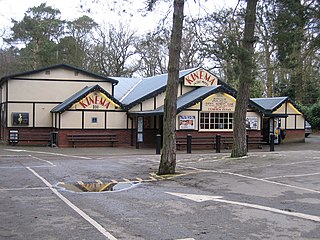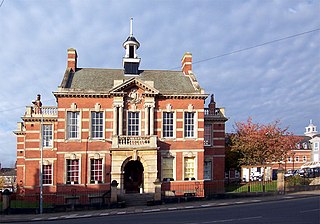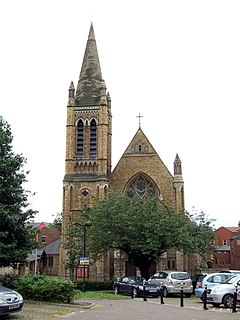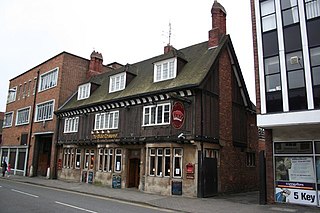
Sir Arthur William Blomfield was an English architect. He became president of the Architectural Association in 1861; a Fellow of the Royal Institute of British Architects in 1867 and vice-president of the RIBA in 1886. He was educated at Trinity College, Cambridge, where he read Architecture.

Woodhall Spa is a former spa town and civil parish in Lincolnshire, England, on the southern edge of the Lincolnshire Wolds, 6 miles (10 km) south-west of Horncastle, 23 miles (37 km) west of Skegness, 15 miles (24 km) east-south-east of Lincoln and 17 miles (27 km) north-west of Boston. It is noted for its mineral springs, cinema and its Second World War association with the RAF 617 Squadron. The cinema has the last remaining rear screen projector in the country.
Thomas Lainson (1825–1898) was a British architect. He is best known for his work in the East Sussex coastal towns of Brighton and Hove, where several of his eclectic range of residential, commercial and religious buildings have been awarded listed status by English Heritage. Working alone or in partnership with two sons as Lainson & Sons, he designed buildings in a wide range of styles, from Neo-Byzantine to High Victorian Gothic; his work is described as having a "solid style, typical of the time".

Edward James Willson, F.S.A., (1787–1854) was an English architect, antiquary, architectural writer, and mayor of Lincoln in 1851-2.

James Fowler JP, FRIBA, known as 'Fowler of Louth', is best known as a Victorian English church architect and associated with the restoration and renovation of churches. However, he was also the architect of a wide variety of other buildings. A listing of his work compiled in 1991 traced over 210 buildings that he designed or restored. He is known to be the architect for 24 new churches and his work also included 40 vicarages or rectories, 13 schools, four almshouses, a Savings Bank, a convalescent home and hospital as well as country houses and estate housing. Most of Fowler’s work was in Lincolnshire and particularly around Louth, but it also included work in the East Riding of Yorkshire, Nottinghamshire, Staffordshire, Suffolk, London, Sussex and even Devon.

William Adams Nicholson (1803–1853) was an English architect who worked in Lincoln and was a founding member of the Royal Institute of British Architects.
Gilbert Murray Simpsonfriba (1869–1954) was a British architect from Brighton who did most of his work in the seaside resort. In 1890 Simpson joined his father Thomas, architect to the Brighton and Preston School Board and the Hove School Board, and helped to design some of the "distinguished group of board schools" for those institutions during the late 19th century. He took over the firm of Thomas Simpson & Son when his father died in 1908, and went on to design several other institutional buildings in Brighton. His elder brother Sir John William Simpson was also an architect.

Charles Bell FRIBA (1846–99) was a British architect who designed buildings in the United Kingdom, including over 60 Wesleyan Methodist chapels.

William Watkins (1834–1926) was an architect who worked in Lincoln, England, and is particularly noted for his Terracotta Revival Architecture.

Charles Kirk (1791–1847) was a builder and architect who worked on many buildings in Sleaford and South Lincolnshire, England.

Michael Drury was an English architect working in Lincoln.

Henry Goddard (1813-1899) was an English architect who was a member of a family of architects who worked in Leicester. He moved to Lincoln and was later in partnership with his son Francis Henry Goddard.

Scorer and Gamble was an architectural practice in Lincoln which operated between 1901 and 1913, although the name Scorer and Gamble continued to be used until 1930. The partnership was between William Scorer (1843–1934) and Henry Gilbert Gamble (1867–1944). The partnership operated from Bank Street Chambers Lincoln. Their work is described as eclectic, ranging from the Arts and Crafts/Art Nouveau of Gainsborough Library (1905) to the more disciplined English Renaissance of Horncastle (1908) and later schools. In 1903, Gamble, who may have been the more talented designer was appointed architect to the Lindsey County Council Education Committee.

John Langwith, Sr. was an English carpenter and architect who worked in Grantham, Lincolnshire. His son John Langwith Jr. (c1753-1825) was also an architect who worked in Grantham.

Herbert C Scaping (1866-1934) was an architect who worked in Grimsby, Lincolnshire in the Arts and Crafts and Art Nouveau styles. He was born in Rathfarnham, co Dublin before his family moved to Hull. He trained with Smith and Broderick of Hull, setting up his own practice in Grimsby in 1890. He became the Lincoln Diocesan surveyor and surveyor to Lord Heneage. Architect to the Grimsby Education Committee and Board of Guardians. His office was at Court Chambers in Grimsby.

Edward Browning was an English architect working in Stamford.

Albert Vicars (1840-1896) was an architect who specialised in Roman Catholic church architecture. He was articled to the Lincoln architect Michael Drury and later worked as an assistant to G.A.Dean. In about 1875 he formed a partnership with John O’Neill at Somerset Chambers, 151 Strand, London.

Traylen and Lenton was an architectural practice in Stamford, Lincolnshire. The practice had offices at 16 Broad Street, Stamford and were the successors to a line of architects working in Stamford, starting in the 1830s with Bryan Browning and continued by his son Edward Browning. The Brownings' practice was purchased by John Charles Traylen in 1888. Henry Francis Traylen became a partner in the practice and sole proprietor after his father's death in 1907. Frederick James Lenton worked as his assistant from 1908 until he became a partner in the practice with Traylen in 1921/2. The partnership had offices in Newark, Grantham and Peterborough, as well as Stamford.

‘’‘Eyre and Southall’’’ were an architectural practice with offices in Retford in Nottinghamshire and Gainsborough. William Southall (1868-1936) and William Eyre were working in the period from the late 1890s to the mid 1930s. Their offices were at 20 Chapelgate, Retford and at Trinity Street in Gainsborough. William Southall had previously worked as an architectural assistant in Marnchester and Dorchester before joining William Eyre. Southall qualified as LRIBA in 1910. William Eyre was also the Gainsborough Borough architect. Their work includes public buildings and housing in the Retford area and in the adjacent area of Lincolnshire. A collection of architectural plans by the practice are in the collection of the Bassetlaw Museum.
Herbert Henry Dunn (c.1865-1935) was an architect who worked in Lincoln in the early 20th century before becoming the surveyor to the Cambridgeshire County Council. He designed buildings in Lincoln and Lincolnshire, before moving to Cambridgeshire shortly before the 1st World War. His most notable buildings in Cambridge are the County Hall which is now part of Christ's College and the Cambridgeshire Shire Hall. Dunn was also the architect for the pioneering Sawston Village College.


















